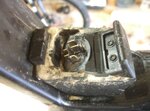Mike leroy
Active Member
What benefits justify additional eBike costs? Scroll to the last post for the answer.
Google Sheet for Cost-Benefit Analysis
The aim of this article is to relate an eBike's benefits to technical detail, your physical ability and subjective opinion. A cost-benefit picture is drawn that reflects your situation, that is easy for everyone to interpret. The technical details and personal information is rated on a scale from 1 to 5. The ratings are the data for the cost-benefits picture.
The same technique applied in text format for EasyMotion bikes.
A Google Sheet to associate 50+ major eBike features (i.e., costs) with benefits. Benefits are rated on a scale from 1-5. Associate any bike feature (i.e., costs) with a benefit. The benefits are categories tailored to your situation. The seven benefit categories in this example are based on Bosch research. The features (i.e., costs) are taken directly from bike manufacturer spec sheets.
The technical features are classified under six benefit categories, according to the relevance for your particular purpose or environment. The benefits score is the average of the ratings that comprise that benefit. Most people refer to this approach as a "software algorithm".
The NINEe 20 electric bike and NINE 60 mountain bike look very similar, but the structural differences are significant. Some of reasons are:
Google Sheet for Cost-Benefit Analysis
The aim of this article is to relate an eBike's benefits to technical detail, your physical ability and subjective opinion. A cost-benefit picture is drawn that reflects your situation, that is easy for everyone to interpret. The technical details and personal information is rated on a scale from 1 to 5. The ratings are the data for the cost-benefits picture.
The same technique applied in text format for EasyMotion bikes.
A Google Sheet to associate 50+ major eBike features (i.e., costs) with benefits. Benefits are rated on a scale from 1-5. Associate any bike feature (i.e., costs) with a benefit. The benefits are categories tailored to your situation. The seven benefit categories in this example are based on Bosch research. The features (i.e., costs) are taken directly from bike manufacturer spec sheets.
(Link Removed - No Longer Exists)
Google Sheet sorted by Cost(above) or Benefit(below)
Google Sheet sorted by Cost(above) or Benefit(below)
(Link Removed - No Longer Exists)
The technical features are classified under six benefit categories, according to the relevance for your particular purpose or environment. The benefits score is the average of the ratings that comprise that benefit. Most people refer to this approach as a "software algorithm".
- Economy
- Elegance
- Excitement
- Endurance
- Enjoyment
- Ease
The NINEe 20 electric bike and NINE 60 mountain bike look very similar, but the structural differences are significant. Some of reasons are:
- Additional weight and motor forces
- Reinforced frame and rims for additional weight and acceleration.
- Additional braking power due to higher speeds.
- Stronger drive chain due to motor.
Last edited:


